Which pool cover is right for my pool? Good question, but I have to answer it with: What do you need from the cover? Do you need the cover to protect your pool from winter weather? Or, do you need a cover that will prevent animals or people from falling into your closed pool? Or, do you need a cover to help keep your pool warm? In this guide, we’ll explain the different types of pool covers, their purposes, plus their advantages and disadvantages.
5 Main Pool Cover Types
- Solid Winter Cover
- Mesh Winter Cover
- Leaf Net
- Solar Cover
- Safety Cover
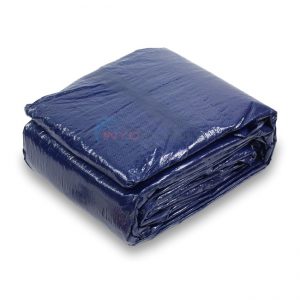
Solid Winter Cover
Pros
- Keeps out rain, dirt, and sunlight
- Lightweight and relatively easy to install
- Inexpensive
Cons
- Requires maintenance during the off-season
- Requires a cover pump
- Durability
Solid winter covers are made of a tarp-like material used for winterizing your pool. The main purpose of this cover is to prevent rainwater, snowmelt, dirt, and sunlight from reaching your pool. Water bags are used to hold the cover in place by rings around the complete circumference of the cover. These covers are excellent at protecting your pool from the elements in most pool scenarios.
Winter covers are available in various warranty lengths. The length of the warranty is usually dependent upon the cover’s scrim count. The scrim refers to the tightness of the weave. Therefore, the higher the scrim count, the more durable the cover, and the longer the warranty.
Scrim = threads per inch (check scrim for currently stocked covers)
The downside of a winter cover is that you may have to tend to it throughout the off-season. It is not a set-it-and-forget cover. Winter covers tend to shift or slide, as a result of their use of water bags instead of anchors like a safety cover. Shifting can be caused by wind or standing water. The collective weight of water bags is heavy, but they are not always enough to prevent the cover from shifting or sinking. Solid winter covers have no way to drain standing water that gathers on top of the cover. Any water runoff will settle on them unless you use a cover (or sump) pump. You must monitor the cover’s debris and water load to prevent it from sinking like a 50-pound tea bag.
Water bags are made from virgin vinyl, a stretchy material, but it is susceptible to tears. The possibility of tearing is increased if you fill them to capacity. Pro tip – leave some room in the bag when filling them to account for expansion when the water inevitably freezes. Also, pets or wildlife paws and claws can pop a bag pretty easily. That is why you will see some pool owners use makeshift weights to hold the cover in place.
How to size a winter cover?
Winter covers are labeled with the pool size they are designed for. The cover itself is usually four to five feet longer on its width and length measurements to allow the cover to reach the pool, with enough leftover for the water bags to sit on. For an example, refer to the winter cover chart picture.
Further Reading on Solid Winter Covers – How To Select an Inground Pool Winter Cover, How To Select an Above Ground Pool Winter Cover


Mesh Winter Cover
Pros
- It does not require a cover pump
- Provides partial protection from sunlight and debris
Cons
- Winterizing requires more chemicals
- Spring start-up is harder
Mesh winter covers are ideal for areas that experience heavy rain or snow during the pool off-season (winter). The cover protects from large debris and most sunlight while allowing water to pass through the cover, eliminating the need to use a cover (or sump) pump to remove standing water. The downside to these covers is that it lets all that water and sunlight through. In addition, the spring start-up for a pool with a mesh cover is more intensive than it would be for a pool with a solid cover. The rain runoff, dust, dirt, and sunlight (great algae food) could turn your water into a lusterless murk by the time spring rolls around. You will need to make sure to have extra chlorine shock, algaecide, and enzyme cleaners on hand to get your water back into safe swimming conditions.
Mesh covers usually come in one warranty length, as the scrim count is less important for mesh models.
Leaf Net
Pros
- Keeps foliage from gathering on winter cover
- Lightweight and easy to install
Cons
- Can be challenging when removing net with full load
- Removing leaf net may compromise winter cover
Leaf nets are unique because they are almost always used in conjunction with another winter cover, solid or mesh. A leaf net’s purpose is to catch leaves and other fall-time debris like pine nuts and needles. Once all the foliage has fallen, the leaf net is removed. The right leaf net for you is determined by the pool size, just as the types mentioned above.
Because of its simple purpose and design, there is not much of a downside. The biggest downside I have experienced is getting a leaf net full of wet leaves out of the pool without sinking the winter cover. Removing a leaf net and the other covers (besides the solar) is a job for more than one.

Solar Blanket
Pros
- Keeps pool water at comfortable temperature
- Easy installation
- Relatively inexpensive
Cons
- Questionable durability
- Requires a reel
Not all pool covers are for winter. A solar cover is an all-season option for pool owners. A solar blanket is essentially a large plastic sheet similar to bubble wrap, which sits on top of the water to trap heat inside.
The blankets are available in 4 primary colors: clear, blue, silver, and black, each touting different insulation properties and the ability to retain or deflect the sun’s heat. On one side of the spectrum, the clear allows sunlight through the cover, which the manufacturer says allows the sun to warm your water, and the cover traps it. The black solar cover allows the least amount of sunlight to pass through.
Solar cover thickness also plays a part in their efficiency. The thicker the cover, the better it will be at trapping heat. MIL is the unit of measure for cover thickness. If you would like to go down the rabbit hole of micrometers, I suggest reading our MIL vs. Gauge guide. If not, I’ll keep it simple by saying the higher the MIL number, the thicker and more insulted the cover.
Further Reading on Solar Covers – How to Size an Inground Pool Solar Cover,
How to Size an Above Ground Pool Solar Cover
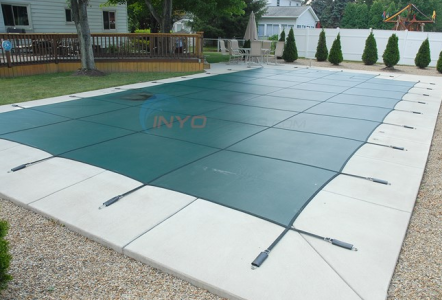
Safety Covers
Pros
- Extremely durable material
- It can hold thousands of pounds of weight
- Prevents children and pets from falling into pool
- Less caretaking needed than winter cover once installed
Cons
- Expensive
- Labor-intensive to install
- Requires drilling into pool deck for anchoring
Safety covers are made of a heavy-duty solid or mesh material coupled with spring-tensioned tie-down straps secured to brass anchors drilled into your pool deck. These covers are meant to protect your pool, but also people. The spring-tensioned straps and super-durable cover material allow them to withstand up to 4,000 pounds (or more in some models). They are designed to prevent people, animals, and larger objects such as cars from falling into the pool, hence the name Safety Covers. These covers are used for winter, or if a homeowner plans to be away for an extended period this cover can ensure there are no surprises when they return.
The main drawbacks of safety covers are the cost and the installation. Safety covers can be eight to ten times the cost of a winter cover, designed for the same sized rectangular pool. If you have a nonstandard pool shape, take that price and add 50 percent for custom charges. The cover’s anchor installation requires using a diamond-tipped drill to bore holes into your concrete deck.
The process of installing the cover is at least a two to three-person job. The heavy tension springs require straps to be tied in a specific order to ensure a secure installation of the cover is in place.
For in-depth information about safety covers – How Can I Match My Pool Safety Cover’s Strap Placement? , How to Fill out a Custom Safety Cover Form, Safety Cover vs. Winter Cover
What are your thoughts on the various types of pool covers? If you have any questions about pool covers, feel free to leave a comment down below or visit over at INYOPools.com


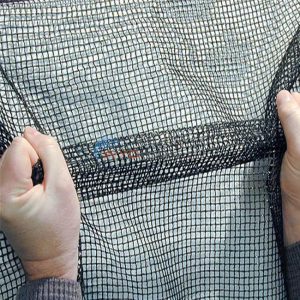


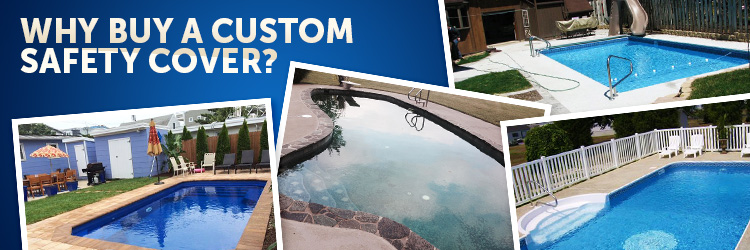

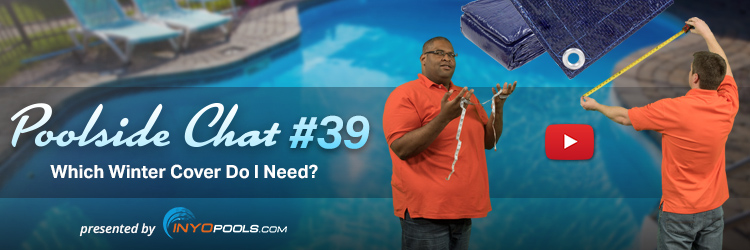






I need a pool cover for a underground pool? I was wondering if u carry the sizes?
We carry covers for inground pools; they can be found on our Pool Closing & Winterizing page.
Have used the solar cover for years. They help prevent evaporation more than heating your pool. Getting leaves and debris off the cover can be a chore. I have tried shop. Vac with a 15 foot wand. Now I just wait for the wind to stop and hose the cover off. Yes dirt and leaves s go into the pool. I then use the leaf catcher net to collect the leaves from the bottom and the skimmer net to clear the surface. The zodiac mx8 w leaf catcher gets the rest. I clean the filter and enjoy the clean pool.